Pick of the Brown Bag
November 6, 2019
by
Ray Tate
Welcome to the Pick of the Brown Bag. This week I review most of the usual suspects plus a couple of new titles. Batman, The Black Cat, Doctor Doom, Fantastic Four, The Immortal Hulk, Miles Morales Spider-Man, New Mutants, Spider-Man/Venom Double-Trouble and Vengeance of Vampirella. Even as I write this, the tweets have already been posted. Check them out if you haven’t the time for the blog: #PickoftheBrownBag.
So. Big. Yellow. Birds. Can’t even stop one Justice Leaguer. Let alone the entire team. Son-of-a-Gun. Who would have thunk it? Me! That’s who!
I don’t know why I continue to hope the X-Men will someday make sense, entertain and be readable. It hasn’t happened in decades. So why am I such a cockeyed optimist?
The New Mutants isn’t the worst X-Men book I’ve ever read, but neither is it as good as the John Byrne/Chris Claremont era of Uncanny X-Men or early issues of Joss Whedon’s run.
Anyway. The best scene in the whole book is the one above. That’s back from the dead Wolfsbane. One of the original New Mutants. She’s just enjoying being alive again. It’s well-illustrated, emotive, given scope and quite lovely.
The rest of New Mutants is mediocre. For those that care, these are the clones of the original New Mutants infused with their proper memories.
Sometimes a thousand words are superfluous when two will suffice: “Yep. Clone.”
Those two words could have dispensed with all the New Age frou-frou. Storm becoming rain-mother and Cyclops sitting like a trickster on a toadstool, which is way more disturbing than a naked Wolfsbane slathered in goo.
The New Mutants currently reside on the living island of Krakoa. Which is funny because the “adventure” truly begins on page ten in space with the swashbuckling Starjammers!
Or maybe the old and boring Starjammers. As dull as their encounter is, couldn’t we have at least cut to the chase? Something like, page two.
Incidentally, revisiting Sam may move somebody, but I don’t know who Sam is.
Aboard The Starjammer, things really start to get cracking. Illyana Rasputin battles the cyborg guy whose name escapes me.
Of course, it’s just a sparring duel. So no worries. Things pick up a little bit toward the end where the New Mutants decide to be heroes.
I’d post a graphic, but I’d rather listen to Bowie. Wouldn’t you? On the whole, I don’t think I’m the audience for The New Mutants. So, if you’re an X-Men fan, well-versed in the College of Mutants, this book may be for you. I, on the other, hand found it remarkably tedious.
The Spider-Man/Venom team-up in Double-Trouble looked like it would be funny, but it’s not. It’s just a light drama with a few strange situations and some stylishly cartoony artwork by Gurihiru.
The story starts out normal enough for Spider-Man and Venom. Spidey stops a bunch of bank robbers. Venom encounters the Green Goblin.
The first odd thing to occur is an homage to The Odd Couple. Spidey attempting to aid Venom with his redemption takes him on as a roommate.
Little does Spider-Man know that Venom’s playing him. He’s got other plans in mind. Those schemes mirror the first few issues of the newest version of Marvel Team-Up.
Another absurdity involves Spider-Gwen. She lives in the same building and suffers from Venom’s sloppiness.
In Spider-Gwen and its rechristening Ghost Spider, Gwen and Marvel Earth proper Peter Parker are just friends. The writers avoid the hassle of rekindling ex-lovers by relying on a considerable age-gap between the two.
In Double-Trouble, Spidey and Gwen are contemporaries. However, this is a kids book and you shouldn’t think about it too much.
Miles Morales Spider-Man is a better option than Double-Trouble. Miles attempting to talk down his Uncle Aaron alias the Prowler from a criminal act is a little like Into the Spider-Verse. However, it’s balanced out by a wicked punch-up.
Miles Morales cracks wise as he and the Prowler go up against Man Mountain Marko. I love how artist Javier Garron makes Marko look like Elvis Presley on steroids in the disco-age.
The Black Cat goes on a date with Batroc Ze Leaper while the Black Fox battles Ninjas.
Writer Jed MacKay demonstrates a flair for dialogue as Felicia gets to know Georges. Minus the talk of heists and heroes, I can really sense the chemistry building between them. Black Cat exemplifies some very understated writing with radiant illustration apropos for the mood, courtesy of Mike Dowling and Brian Reber.
The Ninja stuff is equally impressive, but it’s not often that you get quiet scenes between two people feeling each other out done well in a comic book. Don’t worry though, Batroc and the Black Cat cap their night with a some elegant thievery.
Doctor Doom framed for a crime he didn’t commit turns himself in to the United Nations and some guest-star guards.
Doom appears to capitulate. Dejected, he’s content to quote Shakespeare. In Shakespeare’s play Richard III is a villain. A poisoner and a murderer of kin. Children no less. History presents a more even-handed depiction of Richard. There is in fact zero credibility in Shakespeare’s tragedy. Forensic evidence shows that Richard didn’t even have a hump.
Writer Christopher Cantwell may be looking at Doom in the same way. Much has been written about Doom, but the truth is something else. Certainly, he appears to have nothing to do with the destruction of the Antilion Project.
When series guest-star Kang the Conqueror appears, Doom decides to take the action hero route. Escape, go on the lam, prove innocence.
Hiding and running, he discovers an old ally in a strange place, and it’s here that Cantwell pops in on the Marvel Universe in general. Using an impromptu Spider-Man appearance he adds humor, draws a hilarious and true comment from Victor and overall just create a sense of quirkiness.
At its heart Doctor Doom is a very weird book. Cantwell flips the narrative. The villains take the places of the heroes. Kang becomes the fortuitous cavalry. The mystery villainess becomes the lady that helps the hero out of a jam. Cantwell imbues these scoundrels with a sense of style and panache missing from their typical treatments. We don’t for example expect villains to like music other than Wagner or opera, but Cantwell dares to differ.
This issue of The Fantastic Four is a major upswing. The last chapter setting up this issue was a real snoozer and filled with boring analogues.
This issue is exciting and filled with good stuff like revolts, Thing-fights and daring escapes. The Fantastic Four seek to complete the mission that made them. So, Reed and Johnny repaired their original ship and off they went with better shielding against cosmic radiation.
The team reached the planet they aimed for, and they found communication problems, a prophecy and a group of resident super-humans that resembled the Thunderbolts. They are not the Thunderbolts. So, I was wrong about that.
The story begins in the underworld where Ben Grimm meets the monsters.
For the monsters’ appearances, artists Sean Izaakse and Marcio Menyz just go nuts. This is just a gorgeous gamut of grotesqueness. In thought they reflect the kind of monster Jack Kirby and Stan Lee plotted and wrote. These are not monsters but a people.
Writer Dan Slott contrasts Ben’s plight with Johnny Storm’s fall into the lap of luxury. Similar to the Timothy Dalton James Bond in License to Kill, really. Albeit a different reaction.
The Soul Mate motif becomes a source of not only Johnny’s story, but some rare comedy from Reed Richards and friction between the home team.
Johnny's scene segues to Reed and Sue confronting the Grand Poobah of affairs and the revelation of a secret that he blames on The Fantastic Four.
Like Sue said, this is not on the Fantastic Four. The conclusion of the Poobah’s speech leads to Sue and Reed exemplifying their perfect partnership and dazzling the reader with a superb escape that brilliantly uses their superpowers. More of this, please.
I’ve never been all that thrilled with nesting a superhero universe in the real world. The presence of superheroes should affect change, which is what Hulk writer Al Ewing is getting at.
However, I can’t accept superheroes being complacent while evil things happen in the nation. How can you have Captain Marvel and a government that cages children? The two conflict. That said. This is a riveting story.
However, I can’t accept superheroes being complacent while evil things happen in the nation. How can you have Captain Marvel and a government that cages children? The two conflict. That said. This is a riveting story.
The Immortal Hulk defeated General Fortean and his followers from Shadow Base. Now, the Hulk owns Shadow Base. Working in concert with his alter-ego, Bruce Banner declares war on the Human World.
Banner’s call alarms authorities and triggers a grassroots movement building around an unfair status quo. Our story though begins in a Massachusetts eatery. Banner awaits the arrival of Amadeus Cho.
Amadeus Cho. I never knew who this guy was, nor the reason behind his hype. The brief encounters I had with him never led to anything good. However, Al Ewing employs the character as a sounding board and devil’s advocate.
He uses his youth and inexperience, despite allegedly being one of the smartest people on the planet. The inclusive phrase is an improvement over his usual boasts. As such, Amadeus Cho becomes the perfect addition to this issue. In addition to a mystery guest whose identity isn’t revealed until the final pages. Perfect.
Batman vs Bane. Catwoman vs. Bane. Big Bad vs. Everybody. Tom King presents the difference between Batman before his return to Catwoman and after. His style of fighting, his ability to fully partner up with somebody all changes.
Whereas Batman and Robin were arguably the ideal team throughout the history of comics. The opening of that doubling and the rewrites suggested that Batman was giving orders, and Robin carried them out. As Dick Grayson grew older, perhaps there was more give and take.
Batman cannot order around Catwoman and that makes all the difference. She’s an adult. She’s his lover, and he accepts her as his equal. Together they fish around for ideas and find the means to overcome formidable odds. It also doesn’t hurt to have Mikel Janin on board whose style pendulums to the realistic and the elegance of cartoons.
Vengeance of Vampirella resurrects the title character in dark fantasy detail.
Honestly, I’m a little foggy on how she ended up dead in the first place.
Vampirella is not really a vampire. That is. She’s not a photophobic undead corpse walking around drinking blood to sustain her existence.
Vampirella is an alien from the planet Drakulon. So, it’s fair to ask how can she wake up from being dead. Let me put it to you this way. Kryptonite kills Superman. Superman appeared to die upon being bathed in Kryptonite. No matter, he still survives certain death through alien trickery. Noted by Firestorm in one of the iterations of The Super-Friends.
A beam of some sort hits Vampirella. This beam is courtesy of a transformed Pendragon. Pendragon was one of the original Vampirella cast members. He started off as a mere stage magician. He gained actual magical powers throughout the years until becoming this.
I vaguely remember this transformation as well. Not good on the details though.
Vampirella reawakens as if from a Lazarus Pit, and is a little more feral than usual. Some demons suffer for the jarring.
Nobody to lose sleep over. However, she remembers that most peculiar urge. Protect humans.
Godzilla, Gamera, Vampirella. They all share one thing in common. Despite their being on the surface, monsters, they’re the good guys. That’s what makes them so darn interesting. You expect a giant reptile to wreak havoc and kill humanity. You don’t expect such a being to defend us. You expect a vampire to prey upon humanity. You don’t expect a vampire to be valiant.

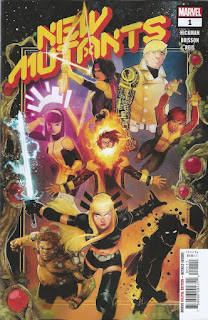




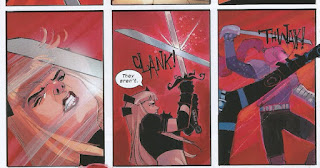



















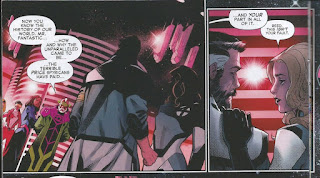







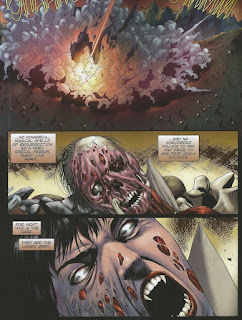
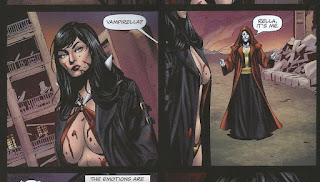

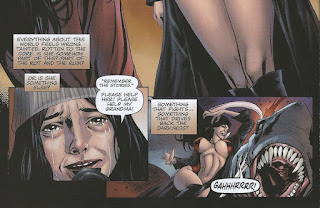
No comments:
Post a Comment